Khadijeh Najafi
QUIET-SR: Quantum Image Enhancement Transformer for Single Image Super-Resolution
Mar 11, 2025



Abstract:Recent advancements in Single-Image Super-Resolution (SISR) using deep learning have significantly improved image restoration quality. However, the high computational cost of processing high-resolution images due to the large number of parameters in classical models, along with the scalability challenges of quantum algorithms for image processing, remains a major obstacle. In this paper, we propose the Quantum Image Enhancement Transformer for Super-Resolution (QUIET-SR), a hybrid framework that extends the Swin transformer architecture with a novel shifted quantum window attention mechanism, built upon variational quantum neural networks. QUIET-SR effectively captures complex residual mappings between low-resolution and high-resolution images, leveraging quantum attention mechanisms to enhance feature extraction and image restoration while requiring a minimal number of qubits, making it suitable for the Noisy Intermediate-Scale Quantum (NISQ) era. We evaluate our framework in MNIST (30.24 PSNR, 0.989 SSIM), FashionMNIST (29.76 PSNR, 0.976 SSIM) and the MedMNIST dataset collection, demonstrating that QUIET-SR achieves PSNR and SSIM scores comparable to state-of-the-art methods while using fewer parameters. These findings highlight the potential of scalable variational quantum machine learning models for SISR, marking a step toward practical quantum-enhanced image super-resolution.
Learning topological states from randomized measurements using variational tensor network tomography
Jun 04, 2024



Abstract:Learning faithful representations of quantum states is crucial to fully characterizing the variety of many-body states created on quantum processors. While various tomographic methods such as classical shadow and MPS tomography have shown promise in characterizing a wide class of quantum states, they face unique limitations in detecting topologically ordered two-dimensional states. To address this problem, we implement and study a heuristic tomographic method that combines variational optimization on tensor networks with randomized measurement techniques. Using this approach, we demonstrate its ability to learn the ground state of the surface code Hamiltonian as well as an experimentally realizable quantum spin liquid state. In particular, we perform numerical experiments using MPS ans\"atze and systematically investigate the sample complexity required to achieve high fidelities for systems of sizes up to $48$ qubits. In addition, we provide theoretical insights into the scaling of our learning algorithm by analyzing the statistical properties of maximum likelihood estimation. Notably, our method is sample-efficient and experimentally friendly, only requiring snapshots of the quantum state measured randomly in the $X$ or $Z$ bases. Using this subset of measurements, our approach can effectively learn any real pure states represented by tensor networks, and we rigorously prove that random-$XZ$ measurements are tomographically complete for such states.
Many-body localized hidden Born machine
Jul 07, 2022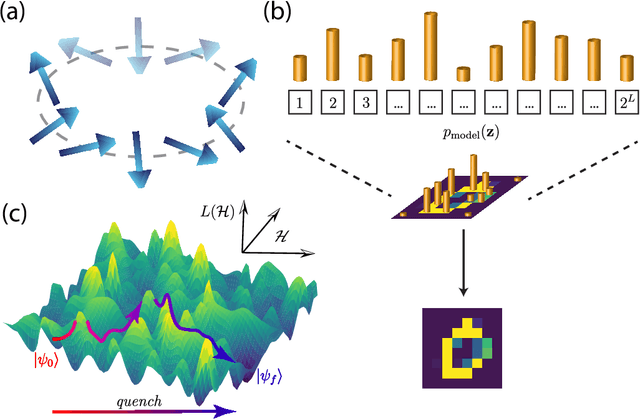
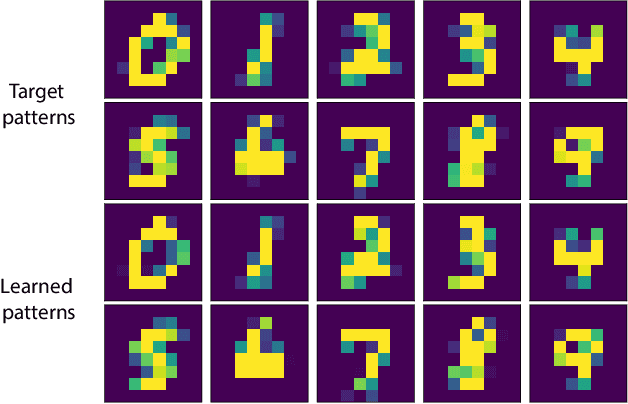
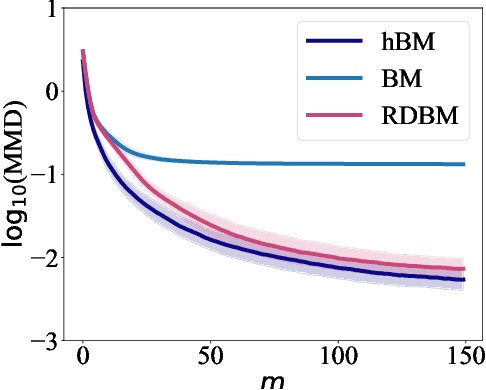

Abstract:Born Machines are quantum-inspired generative models that leverage the probabilistic nature of quantum states. Here, we present a new architecture called many-body localized (MBL) hidden Born machine that uses both MBL dynamics and hidden units as learning resources. We theoretically prove that MBL Born machines possess more expressive power than classical models, and the introduction of hidden units boosts its learning power. We numerically demonstrate that the MBL hidden Born machine is capable of learning a toy dataset consisting of patterns of MNIST handwritten digits, quantum data obtained from quantum many-body states, and non-local parity data. In order to understand the mechanism behind learning, we track physical quantities such as von Neumann entanglement entropy and Hamming distance during learning, and compare the learning outcomes in the MBL, thermal, and Anderson localized phases. We show that the superior learning power of the MBL phase relies importantly on both localization and interaction. Our architecture and algorithm provide novel strategies of utilizing quantum many-body systems as learning resources, and reveal a powerful connection between disorder, interaction, and learning in quantum systems.
Learning quantum symmetries with interactive quantum-classical variational algorithms
Jun 23, 2022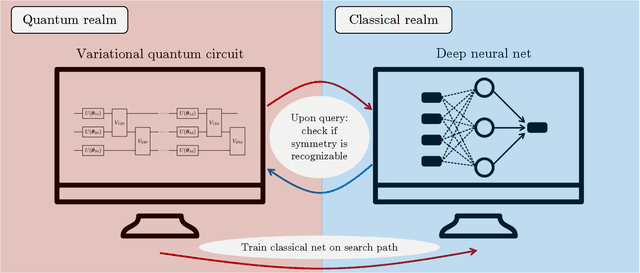
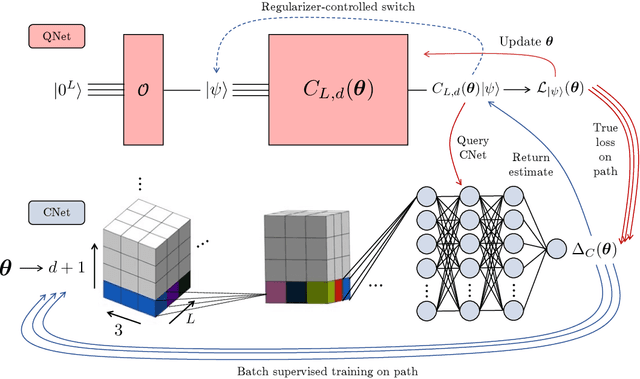
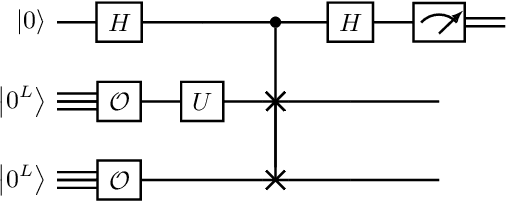

Abstract:A symmetry of a state $\lvert \psi \rangle$ is a unitary operator of which $\lvert \psi \rangle$ is an eigenvector. When $\lvert \psi \rangle$ is an unknown state supplied by a black-box oracle, the state's symmetries serve to characterize it, and often relegate much of the desired information about $\lvert \psi \rangle$. In this paper, we develop a variational hybrid quantum-classical learning scheme to systematically probe for symmetries of $\lvert \psi \rangle$ with no a priori assumptions about the state. This procedure can be used to learn various symmetries at the same time. In order to avoid re-learning already known symmetries, we introduce an interactive protocol with a classical deep neural net. The classical net thereby regularizes against repetitive findings and allows our algorithm to terminate empirically with all possible symmetries found. Our scheme can be implemented efficiently on average with non-local SWAP gates; we also give a less efficient algorithm with only local operations, which may be more appropriate for current noisy quantum devices. We demonstrate our algorithm on representative families of states.
An analytic theory for the dynamics of wide quantum neural networks
Mar 30, 2022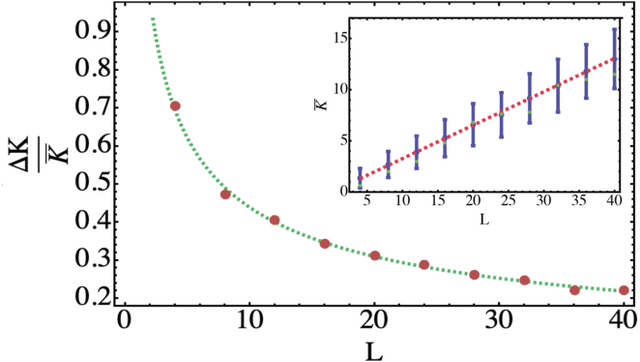
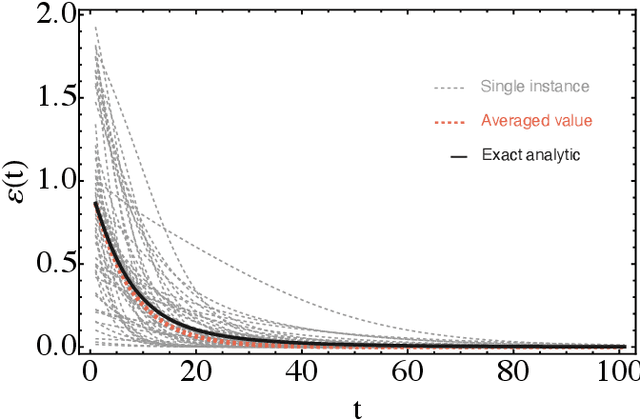


Abstract:Parametrized quantum circuits can be used as quantum neural networks and have the potential to outperform their classical counterparts when trained for addressing learning problems. To date, much of the results on their performance on practical problems are heuristic in nature. In particular, the convergence rate for the training of quantum neural networks is not fully understood. Here, we analyze the dynamics of gradient descent for the training error of a class of variational quantum machine learning models. We define wide quantum neural networks as parameterized quantum circuits in the limit of a large number of qubits and variational parameters. We then find a simple analytic formula that captures the average behavior of their loss function and discuss the consequences of our findings. For example, for random quantum circuits, we predict and characterize an exponential decay of the residual training error as a function of the parameters of the system. We finally validate our analytic results with numerical experiments.
 Add to Chrome
Add to Chrome Add to Firefox
Add to Firefox Add to Edge
Add to Edge